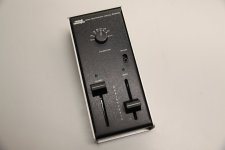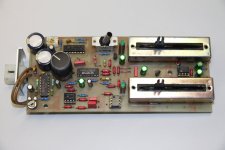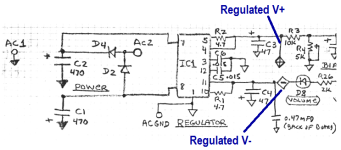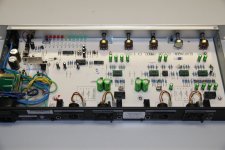Per a theory written in 1960 by Benjamin Bauer, a 2-channel stereo system is flawed by a compromise as each ear hears both speakers (crosstalk). I have been intrigued by this for over 40 years since purchasing the Sound Concepts IR2100 in 1982 (which I still have). This thread will concentrate on older analog solutions such as the Hughes AK-100, SRS PRO 220, Behringer EX-1, and others. Although an electronic solution is not without its own issues, using a stereo imaging processor can bring some enjoyment to music. At this retirement stage of my life, I prefer things to be simple and comfortable. I find having an external processor to be preferable to the acoustic solution of having to have a mattress or a 4x8 sheet of plywood attached to my nose and cones or baffles on my ears. Please feel free to jump in with your thoughts, comments, likes, and questions.
We can start with the Sound Concepts IR2100 Image Restoration Control which was my first foray into crosstalk cancellation. It can still provide stunning results with a wide and deep soundstage provided the source is a well recorded stereo track. The drawbacks are a poor signal-to-noise ratio of barely 80dB which was fine in the day for vinyl LPs and cassette playback. The other is the use of a Bucket Brigade Device where the delayed signals are processed. It is a Reticon SAD512 similar to the SAD1024 used in older guitar effects pedals. Attached is the owners manual with theory of operation and the hand drawn schematic provided to me by Joel Cohen decades ago.
Attachments
Exterior and internal pictures. Unit shown has had PRP non-magnetic resistors and better caps installed. Won't help the s/n ratio but will improve the clarity. Opamps will be replaced with better sounding ones eventually.
Attachments
I'm curious to read about how you judge your old Sound Concepts IR2100 processor to subjectively compare to your much newer and more sophisticated XTC processors?We can start with the Sound Concepts IR2100 Image Restoration Control which was my first foray into crosstalk cancellation. It can still provide stunning results with a wide and deep soundstage provided the source is a well recorded stereo track. The drawbacks are a poor signal-to-noise ratio of barely 80dB which was fine in the day for vinyl LPs and cassette playback. The other is the use of a Bucket Brigade Device where the delayed signals are processed. It is a Reticon SAD512 similar to the SAD1024 used in older guitar effects pedals. Attached is the owners manual with theory of operation and the hand drawn schematic provided to me by Joel Cohen decades ago.
That low-ish 80dB SNR figure is almost certainly due to operation of the bucket-brigade device.
Hi bigskyaudio,Behringer EX-1
Replying to the following your interesting statement from another thread:
"I have all of them but only the upgraded EX-1 is in my system full-time."
Then I gently asked you the following;
"Until a minute ago I was totally opposed conceptually to such a thing, but your post has intrigued me a lot and I've already seen that there are many second hand out there.
What is meant by upgraded?
THX"
Furthermore, out of curiosity, I would like to know also how many years Behringer Edison EX-1 has been out of production. Thanks.
There are at least two reasons why you wouldn't want the delay functioning to be applied over the full audio bandwidth, unless the XTC system features sophisticated dynamic listener head-position detection and correction. One reason is that the head itself provides blocking or shadowing of higher frequency cross-talk, so there's not as much benefit from having shorter wavelength XT cancellation signals applied to the cross-shadowed ears. The other reason is that as wavelengths become shorter, the necessity to accurately establish, and rigidly maintain the acoustic path geometry becomes more critical. Small, natural shifts of your head position can nullify the effect for shorter wavelengths. Which is why simpler XTC processors, such as Sound Concepts', typically feature low-pass filtering of the delayed cancellation signal.
Last edited:
The other processors are not exactly the same type of device as they do not provide a time delayed correction for crosstalk cancellation as far as I know. They are similar in that they all manipulate the stereo difference information (L-R, R-L). The only similar products I am aware of were the JVC BN-5 Biphonic processor and the Carver C-9 Sonic Hologram Generator. The advantage of the IR2100 is that it allows for continuous adjustment of the speaker/listener angle where the C-9 requirement was that one had to sit in a premeasured fixed location while the BN-5 allowed for 3 common settings of 30, 45, and 60 degrees. In my view, the IR2100 produces better results than the Carver or JVC units as it provides the widest and deepest soundstage.I'm curious to read about how you judge your old Sound Concepts IR2100 processor to subjectively compare to your much newer and more sophisticated XTC processors?
I used to be a purist myself and never wanted any add-on devices or even tone controls. Over the years I swapped out many components always in a quest for better sound. I have reached a stage in my life (actually 15+ years ago) where I am satisfied with my listening setup and now concentrate on the music. What a concept! No more stressing or losing sleep over the thought of there might be slightly more resolution if I just change one more interconnect cable."Until a minute ago I was totally opposed conceptually to such a thing, but your post has intrigued me a lot and I've already seen that there are many second hand out there. What is meant by upgraded?"
Furthermore, out of curiosity, I would like to know also how many years Behringer Edison EX-1 has been out of production. Thanks.
The Behringer Edison EX-1 is an early 1990s unit like the Hughes and SRS. They were made for a number of years but I do not know when they were discontinued. I owned and operated a service center for ADCOM and Parasound along with restoring and upgrading power amps and preamps. We did some processors too like the EX-1 where good improvement can be made simply by using better opamps and better quality caps without installing expensive boutique components.
Beautiful recapping, thank you very much for the nice pic! 
However, at the end of the day considering that the most "new" second-hand one out there will be at least 35 years old I think I will remain a purist still for a while...

P. S.: I was wondering if there was an equally valid and affordable recent alternative to try just for fun.
However, at the end of the day considering that the most "new" second-hand one out there will be at least 35 years old I think I will remain a purist still for a while...
P. S.: I was wondering if there was an equally valid and affordable recent alternative to try just for fun.
Last edited:
Totally the same here.I used to be a purist myself
Or adapters of any kind on the signal path or even on AC side, or 10cm more of unnecessary cable/wiring, or a single extra solder not strictly required even on the loudspeakers side, and so on...never wanted any add-on devices or even tone controls.
At the end of the day what I want to satisfy is my certainty of simplicity and of how it was made and why it was done.
Simple and straight must be the mood of my system and of course of what comes out of my loudspeakers: the simpler the better, the straighter the better.
So I've always ignored (I was going almost to say: "hated") completely any device that belongs to the category corresponding to this thread title, until reading your post on the other thread (from there we moved here).
What I liked about your post is the fact that I guessed that you were experienced and especially the fact that after you trying many similar devices there was one in particular that you had remained in the stable in your system, namely Behringer Edison EX-1 .
However, after finding that a second-hand unit would be at least 35 years old, I no longer wanted to have one for obvious reasons, but just wondering if a similar device could nowadays be recommended by you.
Still so for me.thought of there might be slightly more resolution if I just change one more interconnect cable.
As a matter of fact I've just replaced a resistor Mundorf M-Resist Supreme with an ALCOR Wirewound one in the crossover of my loudspeakers (please note that obviously the Mundorf resistor had already replaced the existing standard resistor. Values are slightly different because the Mundorf M-Resist 4R7 was not available illo tempore) just because I'm convinced that the latter (even if not a "boutique" component) sounded better than Mundorf...
Last edited:
I used to be a purist myself and never wanted any add-on devices or even tone controls. Over the years I swapped out many components always in a quest for better sound. I have reached a stage in my life (actually 15+ years ago) where I am satisfied with my listening setup and now concentrate on the music. What a concept! No more stressing or losing sleep over the thought of there might be slightly more resolution if I just change one more interconnect cable.
Similar for me. Until I realized that while such changes did seem to make the sound different, they did not necessarily make it sound better overall.
That Arcol is a nice looking resistor. Since it is gold colored it must be better!As a matter of fact I've just replaced a resistor Mundorf M-Resist Supreme with an ALCOR Wirewound one in the crossover of my loudspeakers...
A very good point.Similar for me. Until I realized that while such changes did seem to make the sound different, they did not necessarily make it sound better overall.
Excellent bigskyaudio, please note that it may (even) be that I'm an idiot - on the other hand no one ever realizes that he is - but even if I'm then I'm not up to that point, trust me (at least once).That Arcol is a nice looking resistor. Since it is gold colored it must be better!
I’ve only done several tests over the years in order to (try to) remove the L-Pads from signal path of my loudspeaker and remembered that Arcol resistors (or related brand, but always of colour GOLD!!!) sounded good.
I didn’t like your useless humor and frankly if I could do I would delete my posts here, as I’m sure you would do too.
Bye!
Last edited:
- Home
- Source & Line
- Analog Line Level
- Electronic Solutions For Stereo Interaural Crosstalk Cancellation



